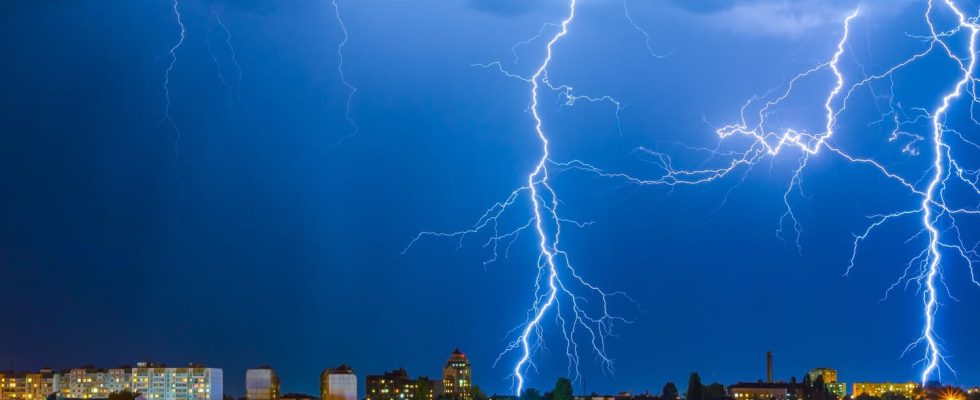Astonishing asthma attacks caused a rush in the Ile-de-France emergency services in June 2023, a few hours after a violent storm. This strange phenomenon is called “storm asthma” or “thunderstorm asthma” in English.
With the stormy episodes of this month of June 2023, a strange phenomenon called “storm asthma” (Or “thunderstorm asthma” in English) occurred in France. “Between Saturday June 10 and Sunday June 11, 2023, the Ile-de-France emergency services took charge of more than a thousand people for asthma attacks (almost 10 times more than usual) and symptoms of allergy or respiratory failure. This unexpected and massive situation can be explained by several meteorological phenomena (heat, high humidity and thunderstorms with gusts of wind, heavy rain) and a peak in grass pollen emissions, with high allergenic potential, to which can be added average air quality, with in particular a relatively high ozone concentration due to sunshine“, explained theIle-de-France Regional Health Agency in a June 15 newsletter, written after several emergency physicians from certain Paris hospitals launched the alert on social networks, in particular on Twitter.
What is thunderstorm asthma?
Thunderstorm asthma refers to a severe form of asthma attack may occur after a big stormparticularly in spring, summer or early fall, when there are lots of grass pollen in the air. In stormy weather, the wind and lightning break and fragment the pollen grains in tiny particles and scatter them in the air. Since these particles are very small, they are not blocked by the trachea and the nose and can easily be inhaled, enter the upper airways and deeper into the lungs and trigger an asthma attack, in sensitive people but even in people who had never done so before, explains the ARS. Symptoms usually appear a few hours after the stormy episode. People with allergies, asthma or allergic rhinitis or hay fever are particularly at risk. This phenomenon, which is rare in France, was first described in the 1980s in England. A wave of “storm asthma attacks” has occurred in Australia in 2016, just after severe thunderstorms hit Melbourne: more than 9,000 people needed emergency medical care and 8 people have died. In 2013, the emergency services of Nantes were also hit by a major spike in asthma attacks following thunderstorms: “from June 7 to 10 2013152 calls for asthma attacks were recorded versus 27 the previous four days”, noted Public health France.
What are the symptoms of thunderstorm asthma?
The storm asthma attack is gradually manifested by:
- A runny nose
- sneezing
- Itchy eyes
- wheezing
- Aggravation of symptoms typical of a seasonal allergy
- Difficulties (dyspnea) or even the inability to breathe
What to do in the event of a thunderstorm asthma attack?
During an asthma attack, what to do varies depending on whether it is an attack that stops quickly or not. If the asthma attack resists treatment (inhalation of a bronchodilator) or if it worsens, you should contact your attending physician immediately (or a doctor on night call) or call the emergency services (the 15th, 18th or 112) who will set up an emergency treatment.
What precautions to limit the risks?
For people with asthma or allergies, during the pollen period:
- Continue to take your asthma medication prescribed by your doctor if you have asthma or continue to take your medication containing inhaled corticosteroids if you are allergic.
- Make sure you always have your rescue inhaler with you
- Check regularly on pollen and weather forecasts from spring to early fall to find out if a storm is brewing and the pollen risk.
- Just before and during storms with gusty winds, stay indoors or in a car with the windows closed and the air conditioner on “recirculation/recycling” mode.
- Avoid outdoor activities that can expose you to pollen, such as outdoor sports activities or garden maintenance.
- Avoid drying clothes outside because pollen settles on damp clothes.
- At home, it is a good idea to rinse your hair in the evening because the pollen settles there,
- Encourage the opening of windows before sunrise and after sunset and avoid exposure to other irritating or allergenic substances such as tobacco, cleaning products, home fragrances or even incense
For the general population: Avoid staying outside in gusty winds during a thunderstorm in an area where there is a high concentration of pollen in the air. Avoid airing your home during the storm or just after so that the fragments of pollen do not enter inside.
- The public health newsletter in Île-de-France – June 15, 2023 – ARS IDF
- Storm Asthma: Severe Weather, Allergies, and Asthma Attacks – Harvard Health Publishing – June 2022
